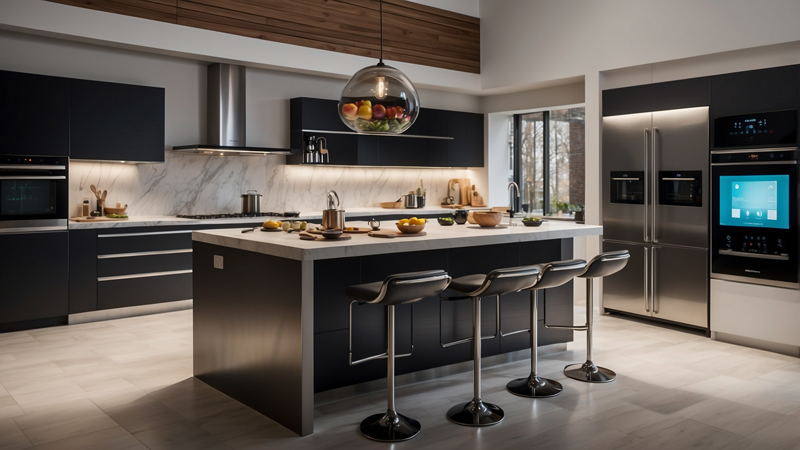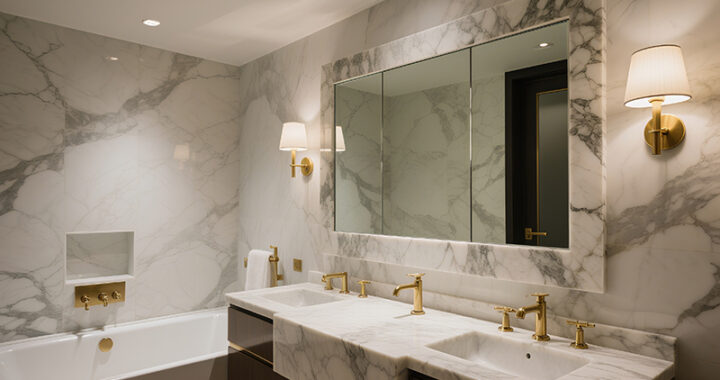How to Create a Smart Kitchen on a Budget

Contents
- 1. Understanding the Smart Kitchen Concept
- 2. Budget-Friendly Smart Kitchen Gadgets
- 3. Key Areas to Focus on in a Smart Kitchen
- 4. Affordable Smart Appliances
- 5. Smart Kitchen Lighting on a Budget
- 6. Voice Assistants and Smart Control Systems
- 7. Smart Cooking Tools
- 8. Smart Kitchen Storage Solutions
- 9. Energy-Efficiency and Sustainability
- 10. DIY Projects to Enhance Your Smart Kitchen
- Conclusion
In today’s digital age, the vision of a smart kitchen—where appliances sync seamlessly, tasks automate effortlessly, and convenience meets efficiency—has shifted from a luxury to a tangible goal for many homeowners. Yet, the misconception that smart kitchens require splurging on high-end gadgets and premium appliances often holds people back. The truth is, building a smart kitchen on a budget is not only possible but can be surprisingly straightforward. With strategic choices and affordable tools, you can transform your kitchen into a tech-savvy space that enhances daily life without draining your wallet. This guide breaks down how to achieve this, step by step.
1. Understanding the Smart Kitchen Concept
At its heart, a smart kitchen is defined by connectivity, automation, and data-driven convenience—not by the price tag of its components. It’s a space where technology works for you, simplifying cooking, reducing waste, saving energy, and freeing up time for what matters most. Contrary to popular belief, you don’t need a full overhaul with $5,000 smart refrigerators or touchscreen-equipped ranges. Instead, a budget-friendly smart kitchen thrives on incremental upgrades: adding small, affordable devices that solve specific problems.
Think of it as building a puzzle: each piece (a smart plug, a voice assistant, a sensor) connects to form a cohesive system. For example, a basic setup might include a smart plug to control your coffee maker, a Bluetooth thermometer to monitor roasting meat, and a voice assistant to set timers—all working together to make mornings smoother and dinners more precise.
The key is to focus on functionality over flash. A high-end smart kitchen might wow with a built-in tablet on the fridge, but a budget version can achieve similar utility with a $20 smart plug and a free app. The goal is to make your kitchen work smarter, not just look smarter.
2. Budget-Friendly Smart Kitchen Gadgets
When it comes to building a smart kitchen on a budget, affordable gadgets are your greatest allies. These small, versatile tools deliver big value by adding smart capabilities to your existing appliances—no need to replace anything. Here are the most impactful options:
Smart Plugs
A smart plug is the unsung hero of budget smart kitchens. Priced between 10–30, these compact devices turn any “dumb” appliance into a smart one by connecting it to your Wi-Fi. Simply plug in your toaster, slow cooker, or even your kitchen lights, and you gain remote control via your phone or voice commands (compatible with Alexa, Google Assistant, or Siri).
The practicality is endless:
- Set a timer for your coffee maker to start brewing 10 minutes before your alarm goes off.
- Forgot to turn off the electric kettle before leaving for work? Shut it down from your phone.
- Sync with your morning routine: When your alarm rings, your smart plug can automatically power on the griddle for pancakes.
Brands like TP-Link, Wemo, and Amazon Basics offer reliable, budget-friendly models that work seamlessly with most voice assistants—making them a must-have for any budget smart kitchen.
Smart Thermometers
Cooking meat to perfection can feel like a guessing game, but a smart food thermometer takes the guesswork out—without costing a fortune (most range from 20–50). These devices use Bluetooth or Wi-Fi to send real-time temperature readings to your phone, alerting you when your steak hits medium-rare or your turkey reaches a safe 165°F.
Unlike traditional thermometers, smart versions let you step away from the stove. Pop the probe into a roast, set your target temperature in the app, and go fold laundry or help the kids with homework—you’ll get a notification the second it’s done. Models like the ThermoPro TP20 or Inkbird IBT-2X even come with preset temperature guides for different meats, making them ideal for novice cooks.
For bakers, some smart thermometers (like the Lavatools Javelin Pro) also track oven temperature, helping you avoid uneven baking due to a faulty oven thermostat—a small detail that can save you from ruined cakes or cookies.
Smart Scales
Precision matters in cooking and baking, and a smart kitchen scale (priced 30–60) elevates accuracy while adding a tech twist. These scales sync with smartphone apps to display not just weight, but also nutritional data: calories, protein, carbs, and more—perfect for anyone tracking macros or dietary goals.
The real magic? Automatic recipe scaling. If a recipe serves 4 but you need 6, input the number of servings in the app, and the scale will adjust all ingredient measurements instantly. No more math headaches or half-cups of flour left unused. Brands like Ozeri and Etekcity offer models that work with popular apps like MyFitnessPal, making meal prep faster and more efficient.
Smart Water Filters
Clean water is a kitchen essential, and a smart water filter (around 40–70) ensures you never run out of it unexpectedly. These devices fit under your sink or attach to your faucet, connecting to your phone to track filter usage. When the filter nears the end of its lifespan, you’ll get a push notification—no more guessing if your water is still safe to drink.
Some models, like the Brita Smart Pitcher, even monitor daily water consumption, encouraging you to stay hydrated. Over time, this small investment saves money by reducing reliance on bottled water and preventing premature filter replacements.
3. Key Areas to Focus on in a Smart Kitchen
To avoid overwhelm, prioritize upgrading high-impact areas of your kitchen first. These are the spaces where smart tech will make the biggest difference in daily life:
Cooking
The kitchen’s primary purpose is cooking, so start here. Even basic upgrades can streamline meal prep:
- Use a smart plug to automate your slow cooker, so chili is ready when you walk in the door.
- Pair a smart thermometer with a voice assistant to “set a timer for 30 minutes, and alert me when the chicken hits 165°F.”
- Opt for a budget smart oven (under $200) with preset modes for pizza, cookies, or roasted veggies—ideal for busy weeknights.
Storage
Food waste is a hidden budget drain, but smart storage tools can cut it down:
- Smart containers (like those from Prepdeck, 15–30 each) use Bluetooth to track when leftovers were stored, sending reminders to eat them before they spoil.
- Smart pantry apps (such as Out of Milk or Pantry Check, free to use) let you scan grocery receipts to build a digital inventory, alerting you when staples like flour or pasta run low.
Cleaning
No one loves scrubbing, but smart tools can automate the drudgery:
- A robot vacuum (budget models like Eufy start at $150) with a “kitchen mode” can clean crumbs off the floor while you cook.
- A smart dishwasher (entry-level options from LG or Whirlpool, 400–600) lets you start a cycle remotely, so dishes are clean by the time you get home.
Energy Management
Smart tech isn’t just about convenience—it’s about saving money on utilities:
- Smart LED bulbs (under $10 each) use 75% less energy than incandescent bulbs and can be turned off remotely if you forget.
- A smart thermostat (like the Honeywell Home T9, $100) adjusts kitchen and home temperatures based on when you’re cooking, reducing AC use while the oven’s on.
4. Affordable Smart Appliances
You don’t need to replace every appliance to go smart—focus on one or two workhorses that get daily use. Here are budget-friendly options that deliver:
Smart Refrigerators
High-end smart fridges with touchscreens can cost 3,000+, but **affordable smart refrigerators** (starting at 800) offer the most useful features without the frills. Models like the GE Profile 17.5 Cu. Ft. Smart Top-Freezer Refrigerator let you:
- Check and adjust temperatures remotely via app (no more “Did I set the freezer cold enough?” panics).
- Receive alerts if the door is left open (saving energy and preventing spoilage).
- Track filter replacement dates for water and ice.
Smart Ovens
A budget smart oven (under $200, like the Ninja Foodi Smart XL Air Fry Oven) combines versatility with connectivity. Features include:
- Wi-Fi control to preheat or adjust settings from your phone.
- Preset recipes for everything from roasted veggies to air-fried fries.
- Integration with voice assistants: “Hey Google, set the oven to 375°F for 20 minutes.”
Smart Coffee Makers
For coffee lovers, a smart coffee maker (around 70–100) turns mornings into a breeze. The Hamilton Beach Smart Coffee Maker, for example, lets you:
- Schedule brew times (wake up to fresh coffee).
- Adjust strength (bold for mornings, mild for afternoons) via app.
- Turn it off remotely if you rush out the door.
5. Smart Kitchen Lighting on a Budget
Lighting sets the mood and affects functionality—and smart kitchen lighting doesn’t have to cost a lot.
Affordable Smart LED Bulbs
Swap out traditional bulbs for smart LED bulbs (8–15 each) from brands like Philips Hue (White Ambiance) or Sylvania Smart+. These bulbs connect to your Wi-Fi or a hub, letting you:
- Dim lights for a cozy dinner or brighten them for chopping veggies.
- Change color temperature: Warm white (2700K) for evening meals, cool white (5000K) for precise prep work.
- Set schedules: Lights turn on at 6 AM to mimic sunrise, or off at 10 PM to save energy.
Motion-Sensor Lights
Install motion-sensor lights (under $20) in dark corners—like under cabinets, inside pantries, or near the fridge. These battery-powered or plug-in lights turn on automatically when you wave a hand or open a door, so you never fumble for a switch with full hands. Brands like Mr. Beams offer compact, adhesive models that install in minutes—no wiring required.
6. Voice Assistants and Smart Control Systems
A voice assistant is the “brain” of your smart kitchen, turning scattered gadgets into a cohesive system. Amazon Alexa, Google Assistant, and Apple’s Siri are all free to use (you just need a compatible speaker, like an Echo Dot or Google Nest Mini, 20–50).
What They Can Do
- Control appliances: “Alexa, turn on the coffee maker.”
- Set timers: “Hey Siri, set a 15-minute timer for the pasta.”
- Answer cooking questions: “Google, how long to boil eggs?”
- Sync devices: “Alexa, start ‘dinner mode’” (which could dim lights, turn on the exhaust fan, and preheat the oven).
Pro Tip
Stick to one ecosystem (e.g., all Alexa-compatible gadgets) to avoid connectivity issues. Most budget devices work with at least one major assistant, so compatibility is rarely a problem.
7. Smart Cooking Tools
Beyond appliances, smart cooking tools make daily tasks easier—without the high cost.
Smart Cookers and Air Fryers
A smart Instant Pot (around 100) takes the classic multi-cooker up a notch: Use the app to start pressure cooking while you’re at the store, or access 1,000+ recipes tailored to your device. Similarly, a **smart air fryer** (like the Cosori Pro II, 130) lets you adjust time and temperature via app, ensuring crispy fries or chicken wings without overcooking.
Smart Stirrers and Mixers
For bakers, a smart hand mixer (such as the KitchenAid Smart Hand Mixer, $80) syncs with an app to guide you through recipes, alerting you when to add ingredients or switch speeds. It’s like having a sous chef in your hand.
8. Smart Kitchen Storage Solutions
Cluttered kitchens waste time and money (ever bought duplicate spices because you couldn’t find the one in the back?). Smart storage fixes this:
Smart Containers
Smart containers (like those from OXO Smart Seal, 15–30 each) use Bluetooth or QR codes to track freshness. Scan the code with your phone, and you’ll see when you opened the container and when it expires. Glass versions are microwave-safe, while plastic ones are perfect for pantry staples like cereal or nuts.
Smart Pantry Systems
For larger kitchens, a smart pantry system (such as the PantryTrack Sensor Kit, $50) uses small sensors on shelves to track inventory. When a item runs low, it adds it to a shopping list in your app. No more last-minute trips to the store for missing ingredients.
9. Energy-Efficiency and Sustainability
A smart kitchen can also be an eco-friendly kitchen, saving you money while reducing your carbon footprint.
Energy-Saving Appliances
Look for Energy Star-certified smart appliances—they use 10–50% less energy than non-certified models. For example:
An Energy Star smart fridge uses about 15% less energy than a standard model, saving $50+ annually.
Smart LED bulbs last 25x longer than incandescent bulbs, cutting down on waste.
Smart Energy Monitors
A smart energy monitor (like the Sense Home Energy Monitor, $300) tracks how much electricity your kitchen appliances use in real time. It identifies energy hogs (e.g., an old oven) and suggests ways to cut back—helping you save on monthly bills.
10. DIY Projects to Enhance Your Smart Kitchen
If you’re handy, DIY smart kitchen projects let you upgrade existing items for pennies on the dollar.
Convert Old Appliances
- Turn a regular lamp into a smart light by plugging it into a smart plug.
- Add motion sensors to under-cabinet lights using a $10 sensor module from Amazon.
- Turn a basic trash can into a “smart” one by attaching a motion sensor to the lid (so it opens hands-free).
Build a Smart Grocery List Board
Mount a cheap tablet (or even a repurposed old phone) on your fridge, and download a free app like Google Keep. Use it to display your smart pantry list, recipe ideas, or a family calendar—all synced to your phone for easy updates.
Conclusion
Building a smart kitchen on a budget is about prioritizing value over flash. By focusing on affordable gadgets, high-impact upgrades, and even DIY hacks, you can create a space that’s efficient, convenient, and tailored to your needs—without overspending. Whether it’s a smart plug that starts your coffee, a voice assistant that keeps track of timers, or a sensor that reminds you to eat leftovers, every small addition brings you closer to a kitchen that works with you, not against you.
The best part? You can start small. Pick one gadget this month, add another next, and watch your kitchen transform—one smart step at a time.


 Best Luxury Bathroom Mirrors for a Stylish Touch
Best Luxury Bathroom Mirrors for a Stylish Touch  Luxury Coastal Home Decor Ideas: Elevate Your Beach House with Timeless Elegance
Luxury Coastal Home Decor Ideas: Elevate Your Beach House with Timeless Elegance  Home Decor Ideas to Make Your Home Feel Like a Luxury Hotel
Home Decor Ideas to Make Your Home Feel Like a Luxury Hotel  Best Luxury Accent Lighting for Every Room
Best Luxury Accent Lighting for Every Room  Best Luxury Candles for a Cozy and Elegant Home
Best Luxury Candles for a Cozy and Elegant Home  Best Luxury Bed Frames for a Stylish Bedroom
Best Luxury Bed Frames for a Stylish Bedroom